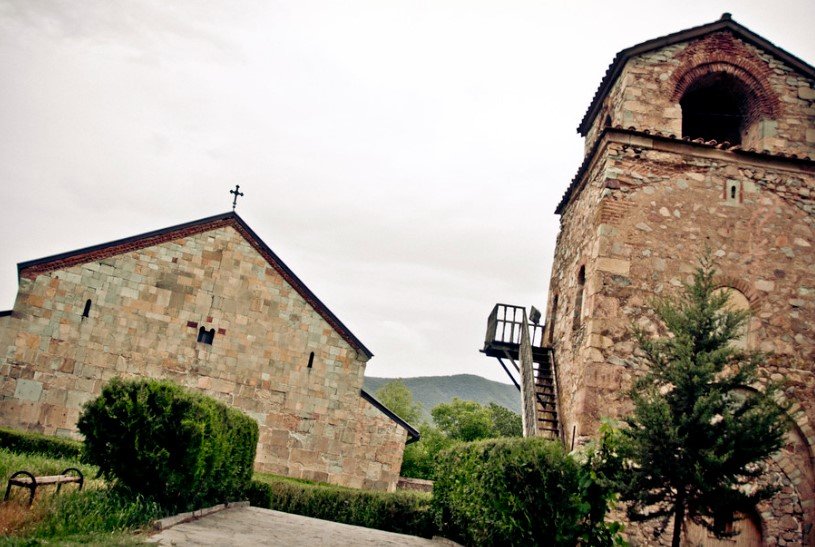Bolnisi Sioni, the oldest standing church in Georgia, holds a paramount place in the annals of world art history. Constructed in the late 5th century, this architectural gem is not just a symbol of early Christian art in Georgia, but also a crucial link in the broader narrative of Byzantine and medieval art. Its architectural innovations, intricate sculptural details, and the unique synthesis of cultural influences make Bolnisi Sioni an indispensable study for art historians and cultural scholars alike.
Architectural Innovation and Influence
Bolnisi Sioni, situated in the Kvemo Kartli region of eastern Georgia, stands as a monumental testament to the rich architectural and artistic heritage of the early Christian period in Georgia. Constructed between 478 and 493 AD, this basilica is the oldest extant church in the country, renowned for its historical and aesthetic significance. The architectural layout of Bolnisi Sioni, a three-nave basilica, reflects the influence of the broader cultural and religious exchanges between Georgia and its neighboring regions.
The basilica’s design bears strong imprints of Sassanian architecture, evident in the use of foliate and geometric patterns that were prevalent in the Persianate world during this period. The capitals and reliefs of Bolnisi Sioni are a testament to the high level of craftsmanship and the deep symbolic thinking of the artists. The intricate carvings include geometric and vegetal motifs, such as interlocking circles, vine scrolls, and acanthus leaves, which symbolize infinity, unity, and divine creation.

These motifs are not merely decorative, but serve as theological symbols, enhancing the spiritual ambiance of the church. The bull head reliefs on the capitals are particularly noteworthy. They exhibit a stylistic similarity to Sassanian art, with parallels found in sculptural works from Hajiabad in Fars, Iran. This indicates a significant cultural exchange and influence from the Persian artistic idiom, which melded with local Georgian traditions to create a unique ecclesiastical art form.
Sculptural Mastery and Symbolism
The capitals and reliefs of Bolnisi Sioni are a testament to the high level of craftsmanship and the deep symbolic thinking of the artists. The intricate carvings include geometric and vegetal motifs, such as interlocking circles, vine scrolls, and acanthus leaves, which symbolize infinity, unity, and divine creation. These motifs are not merely decorative, but serve as theological symbols, enhancing the spiritual ambiance of the church.
The bull head reliefs on the capitals are particularly noteworthy. They exhibit a stylistic similarity to Sassanian art, with parallels found in sculptural works from Hajiabad in Fars, Iran. This indicates a significant cultural exchange and influence from the Persian artistic idiom, which melded with local Georgian traditions to create a unique ecclesiastical art form. Moreover, the incorporation of pre-Christian symbols like bull heads and various birds into the Christian context reflects a unique cultural synthesis.
These elements indicate the assimilation of older religious motifs into the new Christian iconography, providing invaluable insights into the transitional period of religious art in Georgia. The intricate carvings include geometric and vegetal motifs, such as interlocking circles, vine scrolls, and acanthus leaves, which symbolize infinity, unity, and divine creation. These motifs are not merely decorative, but serve as theological symbols, enhancing the spiritual ambiance of the church.
Inscriptions and Linguistic Heritage
One of the most significant features of Bolnisi Sioni is its inscriptions, which are among the oldest examples of the Georgian alphabet. These inscriptions not only date the construction of the church, but also provide valuable insights into the historical context of its creation. The inscriptions are a crucial link to understanding the linguistic and cultural development of early medieval Georgia.
The inscriptions are a crucial link to understanding the linguistic and cultural development of early medieval Georgia. They offer a glimpse into the socio-political and religious milieu of the time, reflecting the interactions between different cultures and the spread of Christianity in the region. The inscriptions are a crucial link to understanding the linguistic and cultural development of early medieval Georgia.
These inscriptions not only date the construction of the church, but also provide valuable insights into the historical context of its creation. The inscriptions are a crucial link to understanding the linguistic and cultural development of early medieval Georgia. They offer a glimpse into the socio-political and religious milieu of the time, reflecting the interactions between different cultures and the spread of Christianity in the region.
